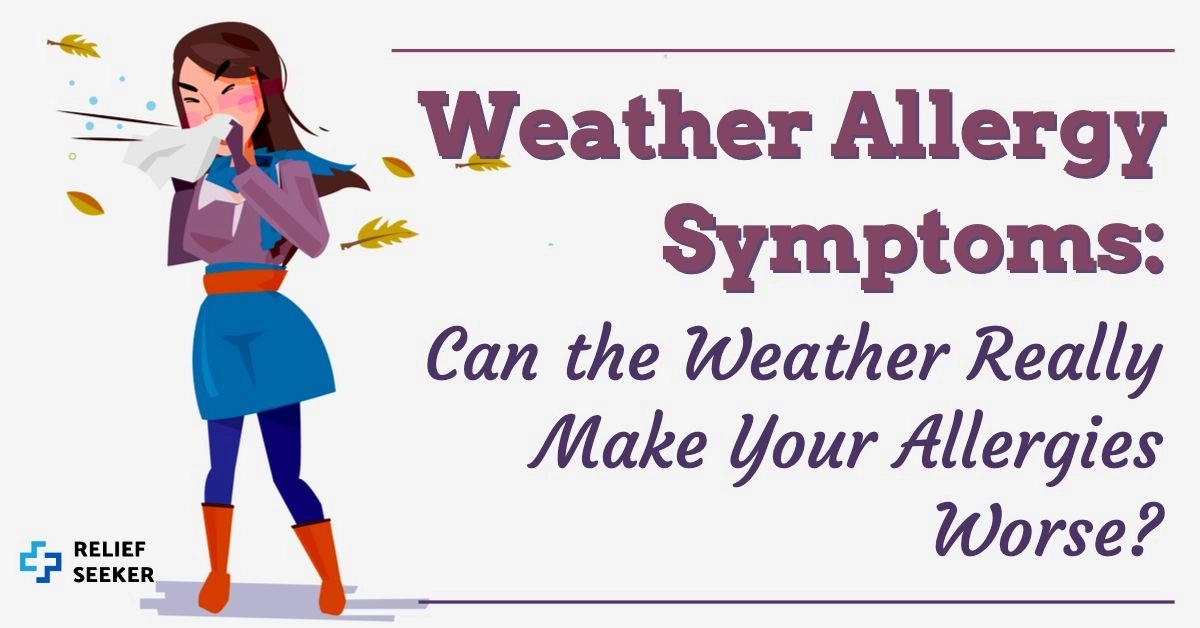Allergies are an immune system response to harmless allergens. The body goes into overdrive trying to protect itself from pollen, mold, mites, and more during an allergy attack.
The most common seasonal allergies are hay fever (allergic rhinitis), pollen, mold, and ragweed.
Yet, how does weather affect seasonal allergies? Can certain weather patterns make allergies worse? Discover the most common weather allergy symptoms — and how to avoid seasonal allergies altogether.
Common Allergy Symptoms
The most common allergy symptoms may include:
Hives
Inflammation
Itchy eyes and nose
Nasal congestion
Red skin
Runny nose
Shortness of breath
Sinus pressure
Sneezing
Watery eyes
Though allergy symptoms may vary from patient to patient, most people suffer from one or a combination of the above symptoms during allergy season.
Types of Allergies
There are three main types of allergies including seasonal, environmental, and animal. Some people are also allergic to certain foods, latex, and chemicals (though these allergies aren’t usually affected by the weather). Common seasonal allergy triggers may include grass pollen, while environmental triggers could include mold spores.
Seasonal Allergies
Seasonal allergies are the allergy symptoms usually experienced in the spring, summer, and fall (depending on where you live).
The most common seasonal allergies are springtime allergies, as they are often triggered by high pollen counts. When the plants bloom in the spring, they drop pollen spores; these spores can become airborne and settle on outdoor surfaces, skin, and clothes. We can also breathe them in, too — resulting in respiratory issues.
The second-most common seasonal allergies are autumn allergies. People that suffer from autumn allergies are often allergic to mold, mildew, and ragweed (which blooms in the fall).
Environmental Allergies
Environmental allergies cause allergy symptoms that can arise any time of the year. These allergens don’t stick around simply for one or two seasons; they can create chaos throughout the year.
The most common environmental allergies are indoor allergies, animal and pet allergies, mold, mildew, cockroach, dust mite, and dust allergies. Sometimes indoor allergens cause worse symptoms in the winter because they can get trapped in the home when windows are shut (and there’s less circulation).
Animal Allergies
Animal allergies are exactly what they sound like: allergens that live on and inside animals. Most people with animal allergies are allergic to animal dander, proteins, saliva, urine, or feces (or they may suffer from symptoms caused by a combination of factors).
Indoor pet allergies are relatively common, as 3 in 10 patients with allergies suffer from cat or dog allergies. Outdoor animal allergies may include allergic reactions to horses, cows, and birds.
Weather Allergy Symptoms: What Weather Affects Allergies?
Unfortunately, nearly all types of weather can induce allergy symptoms. Yet, different allergies are triggered by various types of weather, meaning you may not even notice some weather-related allergies and experience symptom flare-ups with other types of allergies.
Wind
Windy weather can worsen allergies — especially springtime and summertime seasonal allergies.
The allergen that wind can affect the most is pollen. When spring hits, the trees, flowers, and plants start blooming and spreading their seeds (aka pollen). Pollen is a sticky substance that can attach itself to pretty much anything, including cars, lawns, patios, clothing, and skin. It can even float into your eyes if you’re not wearing eye protection.
Wind can exacerbate airborne allergens such as pollen by carrying spores through the air — and directly to your respiratory system.
If you suffer from pollen allergies, you’ll want to avoid going outdoors on especially windy days in the spring and summer (or whichever days pollen counts are highest).
If you do need to go outside, you may also want to mitigate the risk of coming into contact with pollen by wearing eye protection (glasses or sunglasses), long clothing, and a face mask. You’ll also want to remove your clothes once you get back home and take a shower immediately so as to not track pollen inside. You’ll also want to make sure you wash your hair before bed so you don’t get pollen on your sheets (where spores can more easily spread into your eyes).
Rain/Heavy Rain
One of the best weather conditions during spring and summer for sufferers of airborne allergies is rain.
Rain (especially heavy rain) can wash away the pollen that has landed on outdoor surfaces, such as cars, patios, and lawn furniture. A good, heavy rain will also remove the pollen from the air. This is why pollen counts are usually lower the day after a big storm.
If you’re allergic to mold or mildew, you may want to head outside with caution the day after heavy rain. Water can cling to leaves, wood, and moss, creating the perfect conditions for mold and mildew.
Humidity
Humid weather is another condition that’s ideal for anyone who suffers from pollen or other airborne allergies.
Just as with rain, humidity can force the pollen to the ground so it’s less likely to become airborne and make its way to your skin, clothes, eyes, nose, and mouth.
Many allergy sufferers find their allergy symptoms start to subside when the weather starts getting more humid in the summer.
The downside to humid weather is that it increases the chance of an allergy attack for anyone allergic to mold, mildew, or dust mites. Dust mites thrive in the humidity, so most allergy sufferers opt to lower the humidity in their homes with an air conditioner or dehumidifier.
Just as with rain, both mold and mildew are more likely to grow and thrive in humid weather, too. You may want to avoid areas where mold is likely to grow, such as dank, dark places (such as basements) and the forest (where there’s an abundance of wood and leaves).
Cold Air
Cold air can be great for seasonal allergy sufferers. If you live in an area that gets cold enough for frost to develop, your chances of extreme seasonal allergy symptoms will lower because the pollen spores are more likely to die out in cold temperatures.
Extremely cold winters are usually followed by less-severe allergy seasons (in general).
What you want to be careful of in cold weather are environmental allergens. During the winter, you’re more likely to keep your windows shut and turn fans off. Creating a warm environment in the home may be cozy — but it’s also creating a comfortable environment for cockroaches, dust mites, and more.
We’re also more likely to keep our animals indoors during winter, making our homes a magnet for animal-related allergens, including pet dander, hair, feces, and urine.
Hot Weather
Generally, hot weather can be good for allergy sufferers (as long as the weather isn’t particularly windy).
Yet, hot weather can also be an issue for anyone that suffers from asthma. Air pollution levels are more likely to rise on hot days, creating respiratory chaos for anyone with asthma or other breathing problems.
Most weather reporting apps and websites post the daily pollen reports alongside weather reports. If you suffer from severe asthma or other respiratory conditions, you may want to avoid going outside (or spending too much time outside) on such days.
Which Climates Are Worst for Allergies?
Temperate climates: Milder climates where there are few touches of frost or hard freezes means that allergens like pollen are present all year round. In addition, people with allergies often experience a spike in symptoms when they visit warmer climates in winter.
Climate Change and Allergies
The really bad news is that allergies are only worsening, and allergy seasons are getting longer — all thanks to climate change.
Global warming has caused a ‘seasonal creep’, where spring starts much earlier and autumn starts and ends much later. Since spring and autumn are the two worst allergy seasons for most sufferers, these early, warm springs and warm, late autumns can cause even more havoc on symptoms.
Pollen can also die during a heavy frost; if temperatures don’t get cold enough in the winter, the pollen can return the following year — with a vengeance.
Getting Tested for Allergies
Before getting treated for allergies, you’ll want to get tested. Doing so allows you to treat only the specific allergens that are causing issues.
There are generally two types of allergy tests: blood and skin prick tests. Blood tests must be performed in a lab, so you’ll need to get a referral from your doctor or allergist before heading to the lab.
Skin prick tests are performed by an allergist. Your doctor will prick your skin with needles that contain small amounts of allergens. Up to 50 different allergy tests can be performed at once!
If you don’t want to head to an office for testing, you can always order an at-home testing kit from a company such as EverlyWell.
These test kits take a blood sample via a finger prick. Simply order your test online, get your test in the mail, follow the sample instructions, and mail your sample to the lab. Results are generally available within a few business days.
Treating Weather-Related Allergies
Luckily, there are plenty of treatments available for weather allergy symptoms. Allergy relief is just a doctor’s appointment (or a telehealth appointment) away. The most common types of treatment for weather allergy symptoms include prescription medication, over-the-counter (OTC) medication, and allergy immunotherapy.
Prescription Allergy Medication
The most common prescription allergy medications are oral antihistamines, decongestants, steroid nasal sprays, and eye drops.
These medications are prescribed by a doctor or allergist, and patients will receive the exact amount of active ingredients needed to treat their symptoms.
If you don’t want to make a trip to an allergist to get relief, you can always head to an online allergist, such as Picnic. Simply fill out a form, get an online consultation, and start feeling better. Allergy meds will be shipped to the address you provide.
OTC Allergy Medication
Similar to prescription medications, OTC allergy meds provide fast relief of symptoms. The one major downside to OTC allergy meds is that the active ingredient amounts are the same for everyone — meaning you may get too little or too much of an active ingredient.
OTC brand-name allergy meds are also much more expensive than their generic counterparts, so you may end up paying more at a pharmacy or big-box retailer.
Allergy Immunotherapy
Another popular allergy treatment is immunotherapy. This treatment introduces a small amount of an allergen to the body, allowing the immune system to build a resistance to it.
Allergy immunotherapy is available as allergy shots, oral allergy drops (such as the ones sold by online allergist Curex), and allergy toothpaste. Shots are administered at a doctor’s office, while drops are self-administered at home.
If you’re suffering from weather allergy symptoms, there are treatment options available. There’s no need to stay indoors when there’s an abundance of pollen or other allergens floating through the air.


